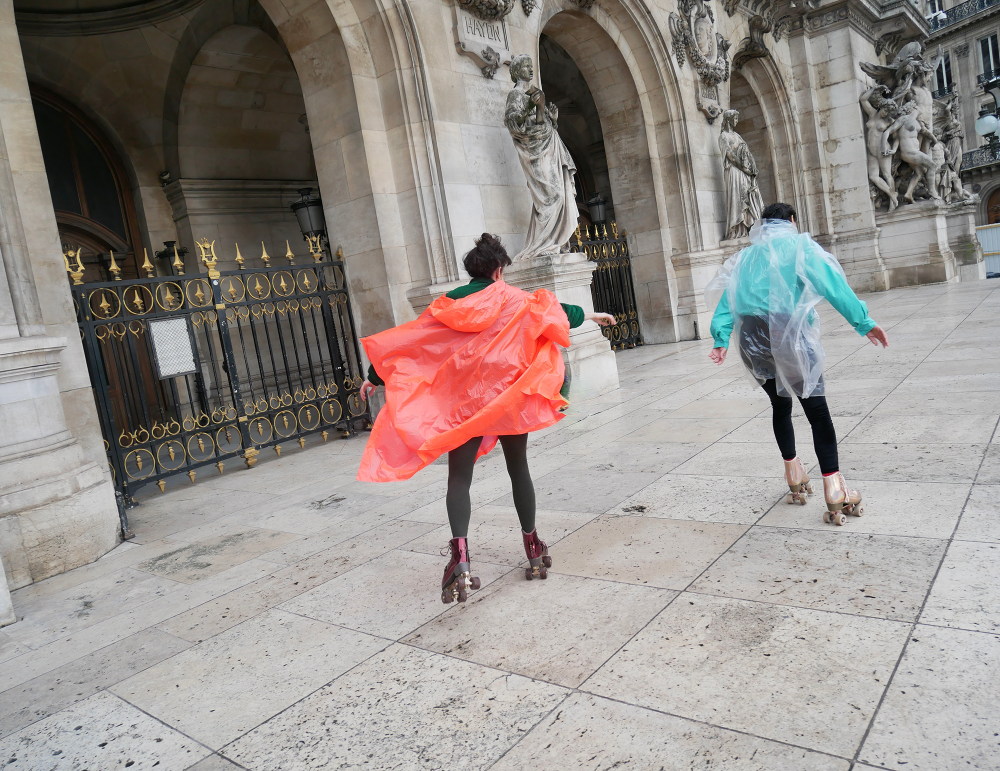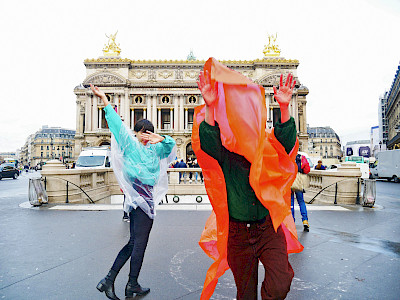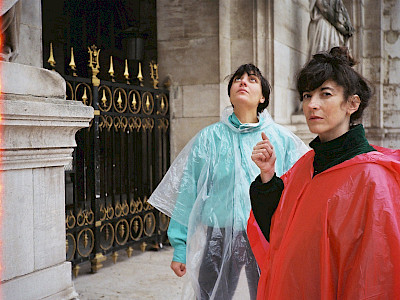17 — 20.05.2023
The mythical figure of the Nymph is that of a carnal body that vanishes and reappears, embodying the rhythm of erotic desire. She is at the heart of one of Debussy's most famous compositions, the Prélude à l’après-midi d'un faune (1894), inspired by a poem by Mallarmé. The Prelude does not tell a story, but recreates the lascivious and sensual atmosphere of an afternoon in music, and would become famous in dance history through a rendition by Nijinsky. A century later, choreographer and dancer Lara Barsacq tackles this enduring image of the Nymph as depicted by men. In her creations, Barsacq often moves within the history of dance, through elements of autobiography, or feminist and queer reflections. After an autobiographical trilogy on the Ballets Russes, she is now at the festival for the first time. Barsacq is accompanied on stage by an interpreter, and they dance, speak, and move, questioning the eroticisation of a body. Together, they create a hymn to the free body, and to dance as a chance to free oneself from a pre-existing idea of sexuality. They move on an explosion of sounds, in which the Prelude breaks down into electronic and synthesizer music, until it is eventually interpreted live by a classical ensemble. A sensual battle with tradition, for a new erotic imagery.
La Grande Nymphe
Lara Barsacq in conversation with Belinda Mathieu
Belinda Mathieu – In your previous pieces, you’ve explored the Ballets Russes, the itinerant dance company that modernised western choreography at the start of the 20th century. What affinities do you have with this period in dance history?
Lara Barsacq – My interest in it was originally personal because my paternal grandmother’s uncle was Léon Bakst, a painter, set designer and costume designer for the Ballets Russes. I put on the piece Lost in Ballets russes in 2018 to say goodbye to my father who I lost as a child. It was a kind of self-care ritual. While I was examining this period in the history of dance, I discovered who Ida Rubinstein was, this dancer and controversial figure in the early 20th century who notably stripped off in 1909 in Oscar Wilde’s Salome. It turned out that it had also been part of my childhood because we had a poster for the show hanging on our kitchen wall. During my research, I immersed myself in countless photos and books about the Ballets Russes and discovered their sensuality, their eroticism and their extraordinary ability to transcribe movement... these pictures made me dance! I found a huge source of inspiration in this rich and diverse artistic period.
How did you make use of this artistic heritage?
I take a very playful approach to the archives. I love putting myself in a position of transforming them so that I’m not sticking to them rigidly but questioning them instead. The archives often contain pictures, but have a great many written accounts as well, notably reviews that can be very hard to read. They convey the opinions and political and social views of that time, which are occasionally shocking, such as anti-semitic articles about Ida Rubinstein and misogynistic ones that focus on the supposed “ugliness” of Bronislava Nijinska. During the creative process, I suggested to the performers that they enter into a dialogue with a selection from the archives and, based on these documents, that together they imagine the dance or ritual that might have existed. When you look at them, what do you see driving the creativity? How can this heritage be transformed by our bodies and our desires?
What material have you used to produce your most recent creation La Grande Nymphe?
I made use of three works: Stéphane Mallarmé’s poem L’Après-midi d’un faune, Claude Debussy’s Prélude à l’après-midi d’un faune and Vaslav Nijinsky’s erotic and scandalous ballet of the same name. Among the references used by the three artists is the great nymph, a mythological character, an unreal woman who is a kind of allegory for carnal desire. This woman – an object of fantasy, a virgin with the ideal body and almost sculpture-like – was constructed by and for the male gaze. We wanted to pay homage to magnificent works of art while appropriating the material for ourselves and taking a subversive look at them.
How did you transform these works?
We wanted to deconstruct the omnipresent male, heteronormative gaze in the history of art to deal differently with these representations and talk about women’s real bodies. This approach posed the question of how to construct a different gaze. I perform this duet with Marta Capaccioli who’s danced in my earlier pieces and who is between femininity and masculinity. On stage, we imagine ourselves to be great nymphs, but we are ourselves with our ageing bodies and our humour, and we play with these differences. We also make use of desire between women in a way that is without inhibition, with the intention of opening up erotic imaginary worlds. I’ve often been interested in female figures who existed but were erased from history or whose importance has been diminished, like the dancer Ida Rubinstein in IDA don’t cry me love and the choreographer Bronislava Nijinska in Fruit Tree, with the idea of reinstating them. In La Grande Nymphe I’m dealing with a woman who didn’t exist but who embodies all women. It pays homage both to the vestiges of the three works, with the desire to be in the past and what this heri-tage gave us, and to female bodies that are emancipated and free.
So is the stage a space of emancipation?
I wanted to critique the heteronormativity that has shaped stale representations, as much for women as for men. To do this, I’ve staged emancipated bodies that are free, with no pressure from society. It’s done in a spirit of joyfulness with the performers who are allowed to show themselves on stage and appear just as they are. It’s a crucial place that allows conviviality to be created on stage, becoming a space of expressiveness where bodies and stories are told and liberated.
In Fruit Tree, music and singing were omnipresent and played an equal role with dance. What place does music have in La Grande Nymphe?
Music has a fundamental place in my work and I love singing. As a dancer, expressing yourself with your voice can be quite a scary act that requires you to expose yourself without being afraid to reveal your vulnerabilities. But I got to like it and now couldn’t be without it. In La Grande Nymphe, our songs are poetic and playful. It’s as if our perceptions took over. Once again, there’s a link with the Ballets Russes, which put stage design, music and dance on an equal footing. For the music, I worked with Cate Hortl, an electro artist of the 1980s who produces dark, cinematographic work. She took Prélude à l’après-midi d’un faune by Claude Debussy and offers a deconstructed and electro version that has a close bearing on the work, toing and froing between the original score and distortions of it. This composition is like a dream that keeps coming back, as if haunting the stage.
- Conversation led by Belinda Mathieu
- April 2023
- Belinda Mathieu is journalist. She writes for Télérama, La Terrasse, Sceneweb.fr, Trois Couleurs, Mouvement, Ma Culture, Trax.
Presentation: Kunstenfestivaldesarts, Charleroi danse
A project by: Lara Barsacq | Creation and performance: Marta Capaccioli, Lara Barsacq, Cate Hortl, Léonore Frommlet, Wanying Emilie Koang, Alyssia Hondekijn | Original music: Cate Hortl | Set design and costumes: Sofie Durnez | Light design: Estelle Gautier | Artistic advice: Gaël Santisteva | Video: Gaël Santisteva, Lara Barsacq | Video animation: Katia Lecomte Mirsky | Music: Claude Debussy | Stage management: Emma Laroche | Sound engineer: Sammy Bichon | Administration and production: Myriam Chekhemani | Communication and distribution: Quentin Legrand / Rue Branly
Production: Gilbert & Stock | Coproduction: Kunstenfestivaldesarts, Charleroi danse - Centre Chorégraphique de la Fédération Wallonie-Bruxelles, Théâtre de Liège, Les Brigittines, CCN de Caen en Normandie, CCN2 - Centre Chorégraphique National de Grenoble in the context of Accueil Studio
Residencies: Charleroi danse, Grand Studio, Les Brigittines, CCN de Caen en Normandie, CCN2 - Centre Chorégraphique National de Grenoble
With the support of: Fédération Wallonie-Bruxelles - Service de la danse
Performances in Brussels with the support of the French Institute and the French Embassy in Belgium, in the frame of EXTRA
With the kind participation of Mrs Coralie Cadène, responsible for the costume heritage of the Opéra national de Paris
Acknowledgements: Astrid Vansteenkiste, Soledad Ballvé, Marion Sage, Sue-Yeon Youn, Marceline Bosquillon, Ivan-Vincent Massey, Benoit Pelé, Heide Vanderieck, Stéphane Barsacq, Julien Fournier, Soline Poteau, Jules Fournier, Belinda Mathieu, Erwan Ha Kyoon Larcher, Les Halles de Schaerbeek, Simon Thierrée, Fabienne Aucant, Daniel Blanga Gubbay, Frédéric Jamagne, Philippe de Lustrac, Erwan Hakyoon Larcher, Stanislav Dobak




